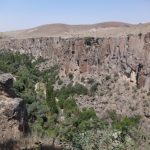Central Anatolia “tiger” town Population: 1,440,000
Old name: Caesarea Mazaca
Favourite son: Abdullah Gül (ex-President)
Kayseri is one of those towns that many people think they’ve been to, although in reality most will only have whisked through the outskirts on their way from the airport to the tourist attractions of Cappadocia. You can’t really blame them for not stopping, since the Kayseri outskirts – all high-rise apartment blocks and never-ending industrial estates – offer not a hint of the town’s illustrious history. But, as Caesarea Mazaca, this ostentatiously modern ‘Anatolian tiger’ was once the capital of the Roman province of Cappadocia.
Nowadays, the town centre is very impressive and served by a flashy tram that stops right in front of the huge Forum Shopping Centre.
Kayseri was the birthplace of Turkey’s eleventh president, Abdullah Gül. Like Konya, it is a town that typifies what the conservative middle classes of Anatolia were hoping for when they elected the AKP government to serve four terms in office.
Don’t leave town without trying:
- pastırma, Kayser’s pungent take on cured beef sold in shop upon shop near the Kapalı Çarşı
- Kayseri mantı, tiny meat-filled dumplings served here with chickpeas
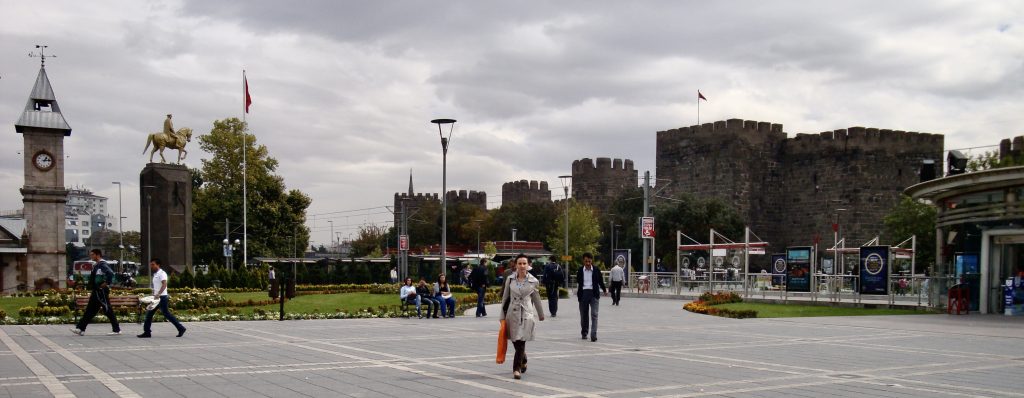
Around town
In the town centre, the clues to the past come thick and fast, not least because the older part of the shopping centre is still concealed behind high basalt walls dating back to the reign of the Byzantine Emperor Justinian (the same Justinian who was responsible for Ayasofya in İstanbul). Of course the walls have been patched up time and time again, most notably by the Seljuk sultan Alaadin Keykavus I in 1224 and by Mehmed the Conqueror in 1486. Their repairs are less easy to make out nowadays since the walls were virtually rebuilt in the early 2000s.
The walls flank what was once Kayseri İç Kalesi (Kayseri Inner Castle), home since 2019 to the Kayseri Archaeological Museum (open daily).
More unexpected is the lively Kapalı Çarşı (Covered Bazaar), slightly to the west. Like its İstanbul counterpart, this is a multi-layered bazaar, its more atmospherically ancient sections tucked deep inside and selling the kind of goods – smelly sheepskins and huge sacks of cotton – that can’t have changed much over the centuries. The Vezirhan in particular is worth tracking down. This two-storied han dates back to the early 18th century when it was built for Damad İbrahim Paşa, the Cappadocian village boy who had risen to become Grand Vizier and son-in-law to Sultan Ahmed III.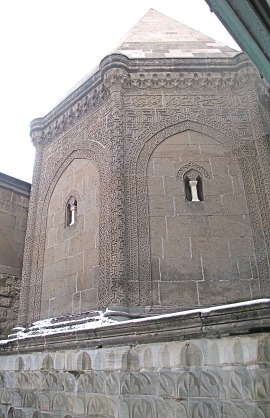
Kayseri flourished under the Selçuks who left their mark all around town. Right in the centre the Mahperi Hunat Hatun complex is still a busy place of worship with a fully functioning hamam that dates back to 1238; this was the first mosque complex built by the Selçuks in Anatolia.
Just to the east, the Sahabiye Medresesi, another Selçuk structure dating back to 1267, has a magnificently elaborate entrance gate which opens onto a courtyard normally filled with bookstalls.
A short walk away across the landscaped Mimar Sinan Parkı is the 12th-century Gıyasiye and Şifaiye Medreseleri (otherwise known as the Çifte Medrese), a pair of religious schools that now house a Selçuk Civilisations Museum (closed Mondays). Unfortunately although some of the exhibits are very beautiful most of the labelling is in Turkish only. The medreses were the gift to the town of the Selçuk sultan Gıyasettin I Keyhüsrev and his sister Gevher Nesibe Sultan who is buried in a domed chamber inside her half of the building.
The Çifte Medrese served as a hospital in the 13th century, and you can inspect the operating theatre, gloomily lit by a hole in the roof, and the grim cells in which patients with mental disorders lived a barely believable four to a room.
Nearby in the park the Avgunlu (Havuzlu) Medresesi survives as a large bookshop-cum-cafe.
It’s also worth popping your head inside the Ulu Cami which dates back to 1142 and a time when Kayseri was governed by the Danışmend emirs. Melik Mehmed Gazi, the third Danişmend leader, was buried in a tomb beside it (r.1134-42). It was finally finished off in 1204 when the Selçuks took control of the town.
Dotted about town are many minor reminders of the Selçuks in the form of pointed double-storied kümbets (tombs), with bands of simple decoration; the most famous is the Döner Kümbet (Revolving Tomb) which stands on the median strip on Talas Caddesi.
Of the many other reminders of the Selçuks around town one of the most impressive is the Şah Kutlüg Han Türbesi, built in 1349 with a magnificent entrance portal. Unfortunately it’s stranded in a car park.
Another impressive Selçuk relic is the Halıkılıç mosque complex built in 1249 and restored in 1547. Its portals are absolutely magnificent. It sits beside a park of the same name.
Of course, like everywhere else, Kayseri eventually fell to the Ottomans and it’s possible to visit the Güpgüpoğlu Konağı, a magnificent mansion built between 1417 and 1419, but set up to show how wealthy Ottomans would have lived in the 19th century when it was home to the poet, composer and government official, Ahmed Midhat Güpgüpoğlu. The painted woodwork of the walls and ceilings is a reminder of the sort of craftsmanship that would have beautified many local homes right up to the 1970s when most of the old mansions were torn down in a rush to modernisation.
Just down the road it’s also worth taking a look at the local Atatürk Evi, which is decorated in early 20th-century style just as it would have been on the great man’s occasional visits.
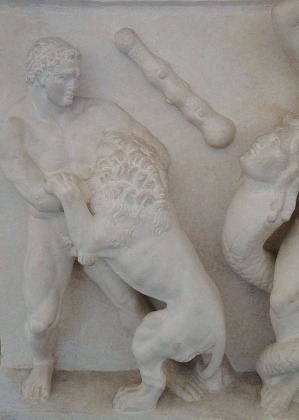
Back in the centre of town a large domed memorial tomb was commissioned for the religious leader, Zeynel Abıdın (1349-1414), in 1886 by Sultan Abdülhamid II to replace a mid-16th-century original.
Written accounts of 19th and early 20th-century Kayseri describe it as extraordinarily beautiful. To get a glimpse of what must have been, you need to wander around the crumbling, neglected Tavuksu Mahallesi behind the Merkez Bankası, where the local authorities are belatedly rebuilding a few of the old stone houses as a reminder of what has been lost.
It’s here that you may also stumble upon Surp Krikor Lusuvoriç, a huge old Armenian church, which, unusually, still retains all its elaborate fixtures and fittings.
In reality, however, most of the written accounts of ‘Kayseri’ were actually describing Talas, an outlying suburb where, behind the usual canyon of high-rises, many lovely old houses still survive today.
Sleeping
Hilton Hotel Tel: 0352-207 5000
Grand Eras Hotel Tel: 0352-330 5111
Hotel Grand Arslan Rather old-fashioned decor but comfortable and in a side street so fairly quiet. Tel: 0352-330 4610
Dedeman Hotel Tel: 0352-342 2115
La Casa Hotel Calls itself boutique but is really just smart business in a central location. Tel: 0352-320 0184
İbis Hotel Tel: 0352-207 3030
Novotel Tel: 0352-207 3000
Ommer Hotel Just across the road from the bus station if you’re making a flying visit. Unlikely to be cheap. Tel: 0352-315 0000
Radisson Blu Good central location on tram route beside Forum Kayseri. Tel: 0352-315 5000
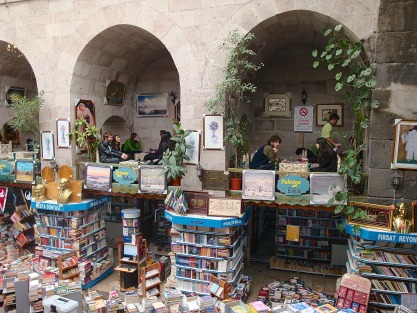 Avgunlu Medresesi
Avgunlu Medresesi
Transport info
Kayseri Airport (ASR) is very close to the town centre. There are daily flights from İstanbul and Ankara with Turkish Airlines and Pegasus.
The flashy otogar is out on the west side of town and offers frequent bus services to Ankara and all the surrounding cities.
The tram doesn’t run right to the bus terminal – to get there from the city centre catch bus number 130 or the İncesu bus. The nearest tram stop is Selimiye but that still leaves a 10-minute walk to the otogar.
On the other hand the tram does run to the Doğu Terminalı for buses to Tormaza. For the Forum Shopping Mall get out at the Büyükşehir Belediyesi stop.
Unfortunately minibuses to other local destinations depart from different places scattered about town.
Day trip destinations
Erciyes Dağı (Mt Erciyes)
Sultan Sazlığı (Sultan Marshes)
Read about the Germir district of Kayseri: http://www.turkeyfromtheinside.com/blogbloggingaboutturkey/entry/24-kayseris-other-face.html
Read about the Talas district of Kayseri: The Talas Trail
Sinan in Kayseri The great Ottoman architect Sinan was a local boy, born in the village of Ağırnas, 27 km from Kayseri, so one might have expected him to have endowed the city with at least one of his masterpieces. Right in the town centre, the Kurşunlu Cami, built in 1574, certainly lays claim to Sinan authorship but, although he may have had a hand in its planning, the mosque doesn’t appear on the most reputable lists of his works. No matter — there’s still a statue of Sinan in the park and even the local municipality, Kocasinan Belediyesi, bears his name.
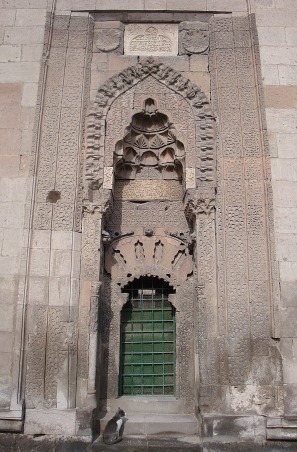 Şah Kutlüg Han Türbesi
Şah Kutlüg Han Türbesi
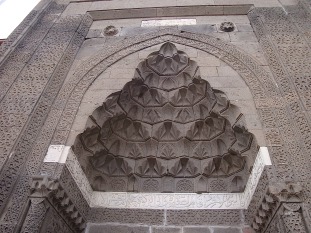 Portal of Halıkılıç Cami
Portal of Halıkılıç Cami

